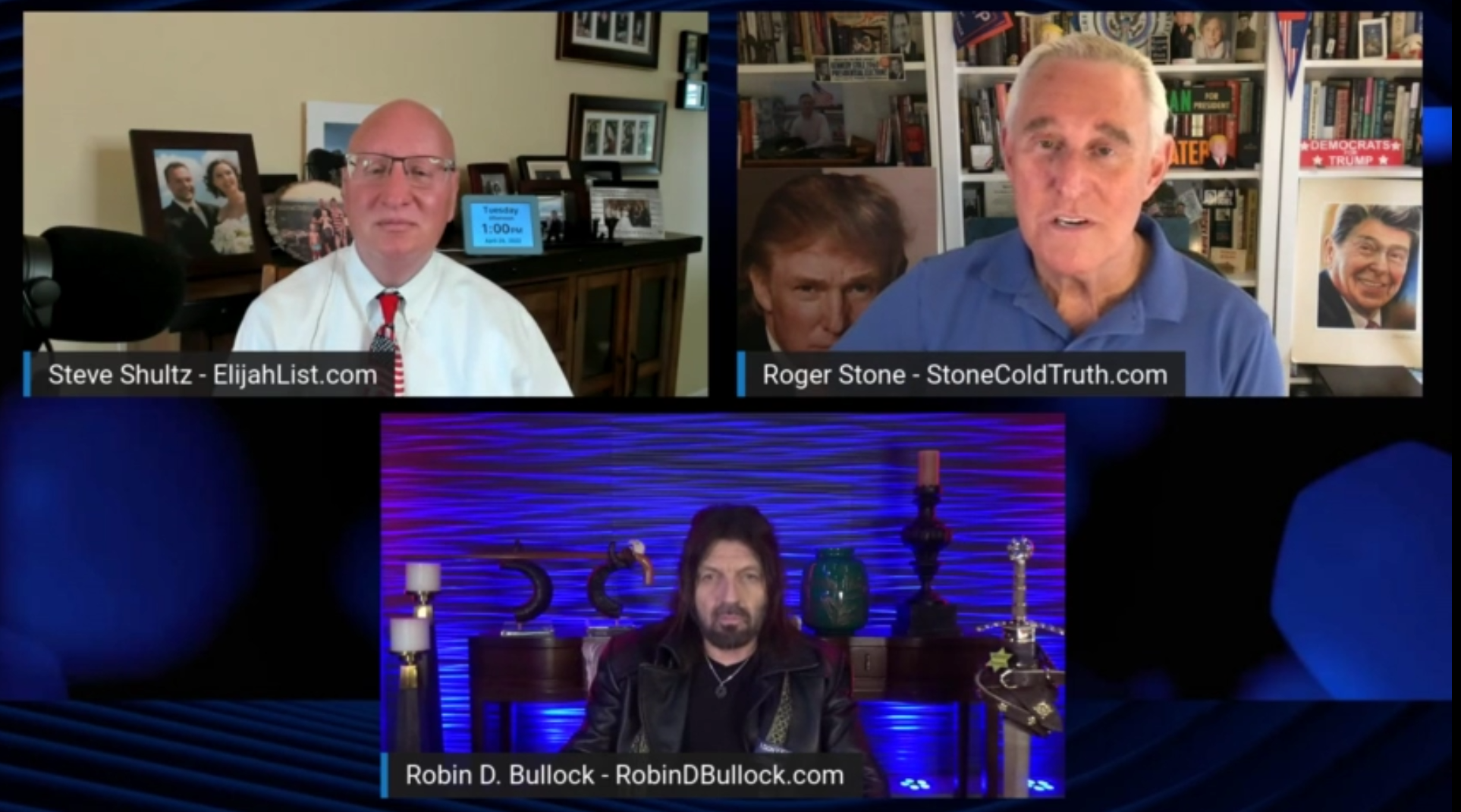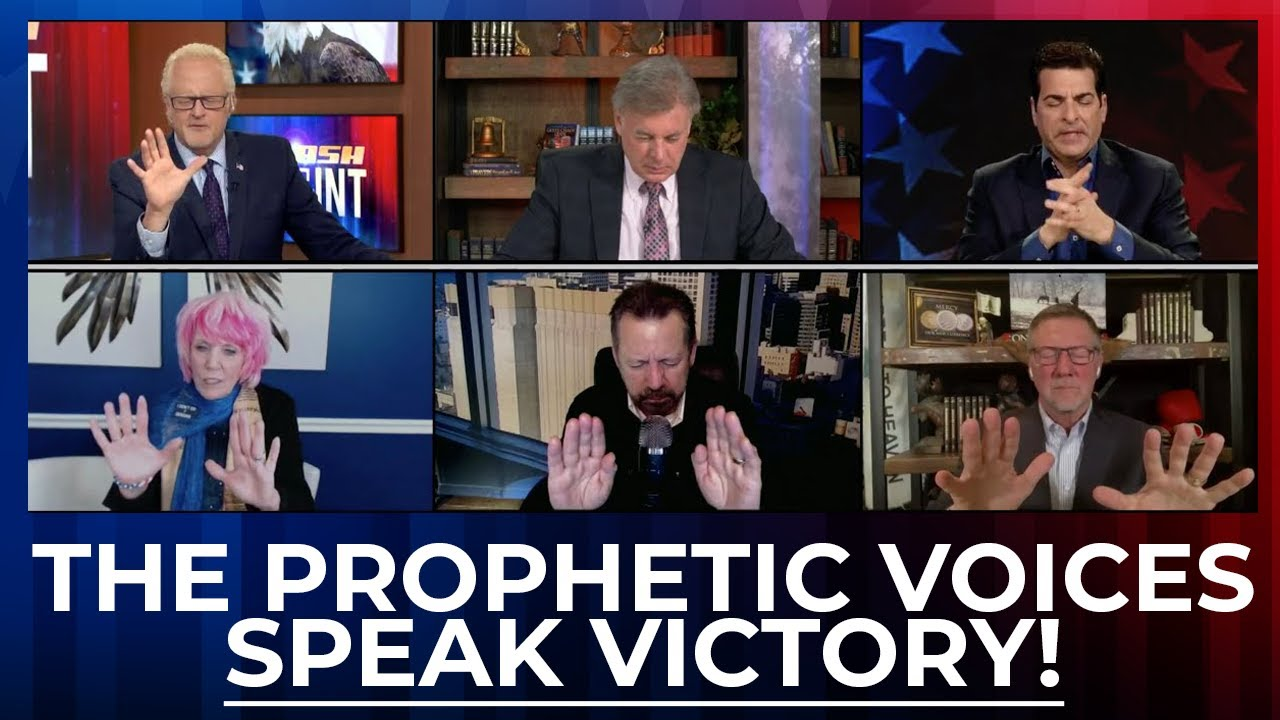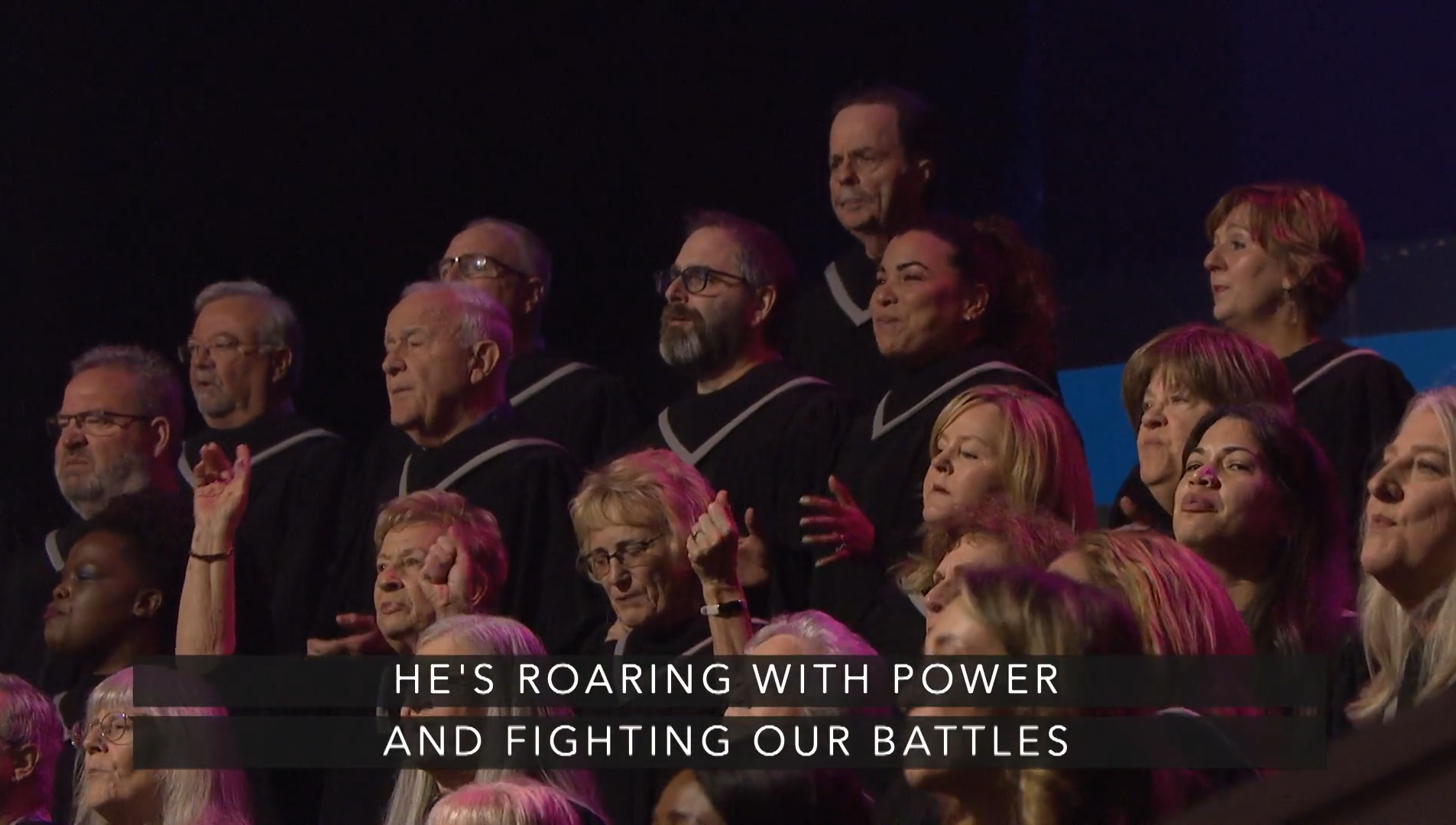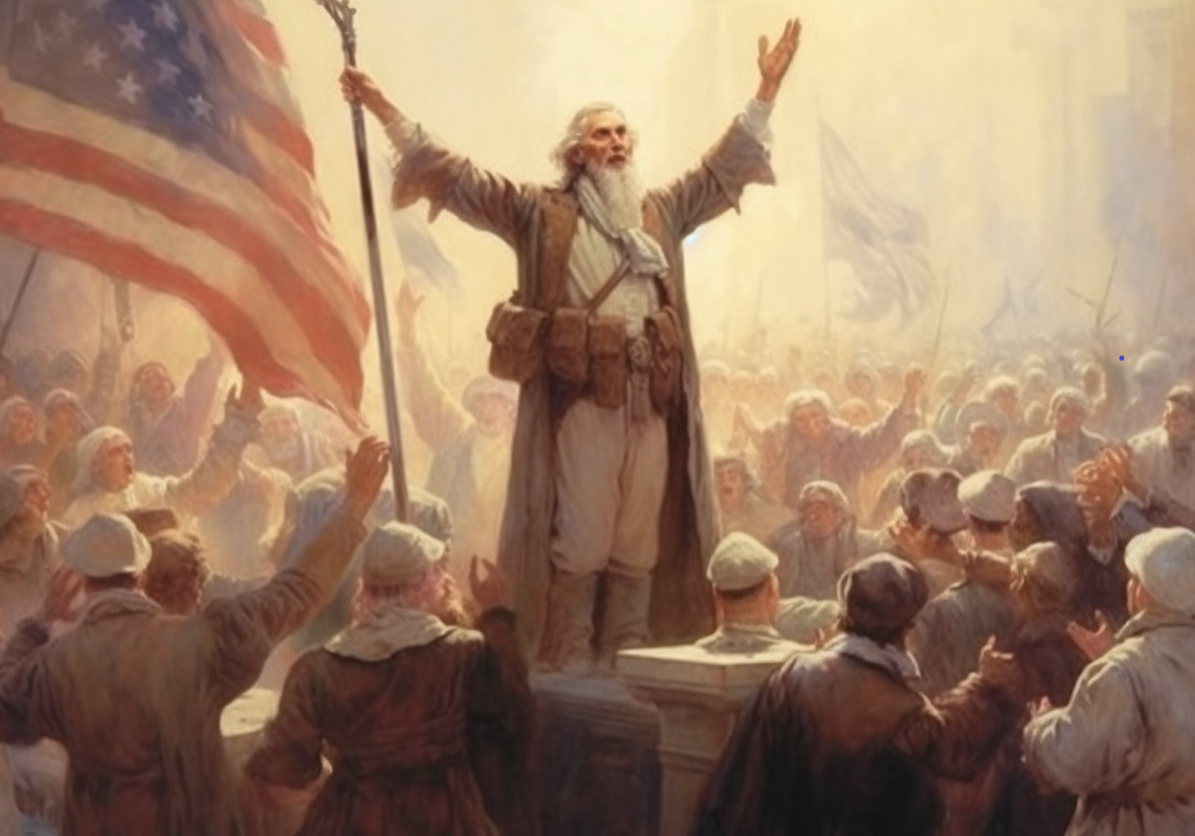Download a PDF of Men of God in the City of Man, Part 4: Epimemetics (paid subscribers only)
Listen to an audio recording of Men of God in the City of Man, Part 4: Epimemetics
Also available at:

Men of God in the City of Man is a nine-part essay series that tells the story of a powerful Narrative virus whose ultimate unintended target was nothing less than faith in American democracy as an institution. Part 1 introduced the idea of the narrative virus as a mechanism for astroturfing (fake grassroots) campaigns, and the idea that the danger may not come so much from forcing new Common Knowledge, but changing what some of the population needed to be true. Part 2 is the story of the carriers of its chief ultimate symptom: a rabid belief in rampant electoral fraud. Part 3 is the story of the creators of the narrative virus and the memetic building blocks they brought to bear. Part 4 is the story of the way in which the special environment into which those memetic building blocks were introduced changed the way that they expressed themselves on major social and cultural institutions.
I am deeply indebted to the work of James Beverley, Matthew Taylor and Paul Djupe in various areas of this essay series. I have attempted to source their work where possible, but if you see something unsourced that makes a clever observation about our subject matter, please do me the favor of assuming it is the work of their dutiful scholarship.
Social media made you all way too comfortable with disrespecting people and not getting punched in the face for it.
Mike Tyson, from a now-deleted Facebook post in 2020
Have you ever watched a mother rat nurse and care for its young?
When I was writing, I intended this to be a rhetorical question. Then I showed a draft of this essay to three people and the first two both said, “yes.” Serves me right for marrying a girl from a family of wildlife rehabilitators.
Anyway, you damn weirdos, watching mother rats nurse their babies is exactly what a group of Canadian researchers did back in 2004, after which they published their findings in Nature. The scientists explored two distinct care patterns among different mothers of rats during their early nursing periods: (1) licking and grooming (LG) and (2) arched-back nursing (ABN). What they found is that the offspring of rats whose mothers exhibited high tendencies toward LG and ABN tended to demonstrate lower hypothalamic pituitary adrenal (HPA) response to stressors. In other words, rats with affectionate moms tended to be less neurotic and fearful, and tended to retain this trait for most, if not all of the rest of their lives. They also tended to be more likely to pass it along to their own offspring.
On its surface, this seems like exactly the kind of thing which might be propagated through the normal means of genetic mutation and selection. That is, lower HPA response seems like it could well be a well-adapted trait in some environments, and one that might facilitate favorability of mutation of associated traits (e.g. stronger mothering instinct).
But that isn’t what they found.
Turns out, you can take rats from a low-LG, low-ABN mother and swap them into a high-LG, high-ABN nest and get basically the same lower lifetime HPA response as if they were biological children of the doting dam. What’s more, the researchers found this to be the result of modified expression of the glucocorticoid receptor gene that would manifest in the offspring themselves. In other words, attentive rat mothering begets multiple generations of attentive rat mothering.
Since this is a site about language and not a site about rats, here’s an aside and a slice of language without so much rat in it: Phenotype means the observed properties of a thing. Genotype means the hereditary information for whose impact on the observable properties of a thing we have empirical data and theoretical propositions. Phenotype is me having blue eyes, dirty blond hair and a second toe that’s unnervingly longer than the big toe. Genotype is me having a set of genes which, based on various studies, would be understood to produce blue eyes, dirty blond hair and a second toe that’s unnervingly longer than the big toe.
All sorts of studies into phenotypic plasticity (i.e. the capacity of organisms of similar genotype to produce varying observable properties in different environments) over the last two decades have produced similar findings to the rat studies, very often in animals undergoing rapid phenotypic change in response to equally rapid changes in environment. We are observing phenotypic plasticity in some species and environments that far exceeds what we would have predicted based any model of expected drift from genetic mutation and environment alone. Not only that, through mechanisms we are still working to understand, this “excess” non-genetic phenotypic plasticity appears in many cases to be heritable across multiple generations. It also appears to mutate very quickly relative to the more familiar polymorphisms of genetic mutation. All of which brings into real question the role that it may have played – and may continue to play – in the process of evolution itself.
We’re talking about epigenetics.
Like its pop-science cousin, quantum mechanics, epigenetics is a field prone to Deepak Chopraization. As you might imagine, the knowledge that non-genetic external stimuli might affect and change how are genes are expressed is ripe for abuse by healing crystal pushers and the essential oils aficionados. You can’t escape the MLM mafia.
But we needn’t be all misty-eyed and mystical about it. The dry science of epigenetics is WAY more interesting, anyway: organisms and groups of organisms drift, sometimes rapidly, from other populations of comparable genetic makeup based not on genetic mutations but on non-genetic changes in how their genes are expressed and transcribed.
You may recall that we recently wrote that narrative is every bit as alive as you or I. Or that gross pile of baby rats.
In the same way that our DNA provides ready instructions for our interaction with the physical world, narrative provides ready instructions for interaction with the social world. In the same way that genetic mutation provides paths for the selection of certain traits, so too, do narratives evolve based on the traits that made it easier for them to reproduce and spread. And in the same way that epigenetic forces create heritable biological features that are not themselves part of the genetic makeup of an organism, often by affecting how the organism reads and responds to those genetic instructions, so too do Epimemetic forces create heritable cultural features that are not themselves part of the memetic makeup of a society, yet influence it in lasting ways all the same.
In simpler terms, by epimemetics, we mean anything which structurally and persistently changes the ways in which we, as a culture and as members of that culture, systematically read and respond to stories, narratives and the memes from which they are constructed.
Major world events that can do that – things like wars, cataclysms, epidemics. But the really big, really sweeping changes in the expressed heritable cultural features of human society have come through three pivotal human developments. Three separate epimemetic revolutions.
The development of language.
The development of the printing press.
The development of television and radio.
None of these things changed the great memes of human culture. Not directly, anyway. But each successive revolution gave those memes new expression, new forms that shaped its influence on a society. Imagine a Meme like Loyalty to Family, a thing which certainly existed and manifested in some form of common knowledge while we were still grunting and gesturing to get our point across to one another. Now consider how that meme in the wild – its phenotype – would have been affected not by its own evolution but by the introduction of language. Of the printing press. Of film and radio. The expression changes dramatically with each. The genotype of so fundamental a meme has evolved and mutated hardly at all. The phenotype, however? It’s a completely different animal, both literally and figuratively.
Same thing with just about any kind of meme. How did the contemporary cultural expression of Messianic memes that suffuse so many societies change when Gutenberg and Luther collaborated (unknowingly and a century apart) to make a plain Bible available to plain people? How did the contemporary cultural expression of universally applicable memes of Fear of the Alien change when Orson Welles read War of the Worlds on American radio waves in October 1938?
Social media is the fourth epimemetic revolution.
To be clear, by “social media”, I don’t mean people chirping at their vaguely racist uncle on Facebook. I don’t mean anonymous trolls sniping at celebrities on Twitter. Neither do I mean vulnerable teenagers aggravating their severe body dysmorphia by surfing Insta all day. Nor am I referring to the time-honored practice of providing the Chinese Communist Party with data on the kinds of household chemicals American teenagers might be willing to ingest on camera for likes on Tik Tok. OK, I mean all of those things, too. But mostly, by “social media” I mean the way in which the internet facilitated rapid formation of online communities and dissemination of content and common knowledge about that content within those communities. By “social media”, I mean the way in which, with apologies to Mr. Tyson, we all got way too comfortable with disrespecting people and not getting punched in the face for it.
By “social media” I mean how it took perhaps a decade to foment a complete shift in the nature of the bulk of human communication, from one-to-one to one-to-many.
Every one of a thousand conversations that used to be between a couple of people is now a conversation conducted in front of a live audience. This has transformed much of our world – certainly the cultural, social and political worlds with which we interact – into a panopticon, a prison in which the inmates are always visible to one another, where the knowledge of constant peer surveillance stifles “wrong” behavior. The panopticon changes how we communicate. It changes how we formulate ideas that we intend to communicate. It changes how we think. It changes how we are affected by and respond to exposure to the oldest memes in the world.
Think, for a minute, about how you form thoughts and words in a conversation with a close friend or family member in the privacy of your home. Now think about how you formulate a post on social media, even a post that is principally for the consumption of a smaller set of individuals. Now think about how much your exposure to the latter has affected the way that you think about formulating all of your communication, all of your conversations, even if only at the margin. That’s what we mean by the epimemetic effect of social media.
In the same way that a substantial change in mean water temperature may change the phenotypic expressions of an animal’s genetics, so too do the change in the primary mode of communication and the institution of a constant panopticon change the phenotypic expressions of a narrative’s memes.
What were the “environmental changes” that social media brought about?
- The vast increase in the size of, connectivity between and depth of relationships among existing and emergent networks of individuals;
- The democratization of content delivery, especially of video and audio content; and
- Panopticon effects, which allowed for the rapid emergence of norm enforcement and purity tests.
Now, back to the matter at hand.
Bear in mind that these environmental changes were occurring at the same time that memes of Rediscovering the Old Ways, Keeping Ancient Covenants, Mountains to be Conquered, Hope for Broken Vessels and A Faithful Remnant Returning were being forcefully inserted into that environment. The change was also taking place as a smattering of (previously but no longer!) isolated prophets began to speak in public about Trump as having been prophetically guaranteed two terms by God.
Starting to see where this is headed?
Well, you still have to watch. Slow-motion train wrecks are like that. Sorry, I don’t make the rules.
The Explosive Growth of Network Density

Jesus said to them, “A prophet is not without honor except in his hometown, among his relatives, and in his household.”
Mark 6:4 (CSB)
The life of a prophet has always been a lonely one. It’s sorta part of the deal.
The popular image of the prophet Elijah is usually one of the dusty-sandaled man on the run from Jezebel, alone in the desert for 40 days and 40 nights, or else hiding in a cave. That image goes double for John the Baptist, Elijah reborn, the man who first took on the mantle of “voice crying in the wilderness” when he claimed those words (from Isaiah 40:3) as his own.
So it was for many of the early years of the prophetic movement in the United States.
Sure, there were people who claimed prophetic gifts and established large, thriving ministries. We mentioned Bill Hamon in Part 3, along with many of the Big Tent folks of the mid-century years. You could catch Benny Hinn if you tuned into the right channel at the right hour of night. But the prophetic movement within the charismatic-Pentecostal church was largely one of many individual voices crying in the wilderness. In the world of narrative, this is a big deal. Private knowledge, even widespread private knowledge, is not the same as common knowledge. It isn’t something that we all know that everybody else knows.
This gap between private knowledge and common knowledge is an even bigger deal for modern Christian prophecy. There is a stylistic preference within the charismatic-Pentecostal tradition for prophecy that rhymes with or confirms other prophecies. There is a certain credibility attributed to prophecies, imagery or language that a “lot of prophets are hearing” at the same time, or in a similar way way. Even a single credible prophet making a claim of a word from the Lord is going to be given far less credence and his words far less power than several prophets saying the same thing in a way that we all know everybody else heard.
Such was the nature of a pre-internet world, however, that these fringe voices really didn’t have a platform to start saying the same things and relying on the same memes. There was even less of a platform for everyone in the charismatic-Pentecostal church to hear those prophecies and know that everybody else heard them. And the well-behaved, cessationist evangelicals were not particularly interested in using their platforms to amplify some of the things those rascally charismatics and Pentecostals were up to.
The forming apostolic networks mentioned in Part 3 were a start. These informal alliances of apostles associated with prophets, churches and other parachurch ministries started to connect some dots between “strategy” and “what the prophets were saying.” It was still slow. It took two decades, for example, before the seeds of a renewed cultural mandate planted by Bright, Cunningham and Schaeffer began to sprout into dominion theology as a canonical doctrinal tenet of this faith community. Visions of a Third Great Awakening had been bouncing around since the early 20th century, despite the tendency toward premillennial, pre-tribulation Eschatology within the charismatic-Pentecostal movement. Even with fits and starts over more than a century, it never really coalesced until our narrative virologists successfully inserted Keeping Ancient Covenants and A Faithful Remnant Returning memes into the narratives of the charismatic-Pentecostal church in America. That’s the problem with widely-held private knowledge: everyone is mutually surprised that their ideas seem to be catching on but not catching fire.
It should be no surprise that, for those who wanted the office of prophet to have more honor in the hometowns of charismatic-Pentecostal churches, there was an agitation toward the bringing together of prophets – and people who believed in the prophetic and other spiritual gifts. Many of these agitations produced large conferences and stadium-filling events for charismatics. Even though they were typically temporary, only a day or a weekend long, they kept common knowledge of the progress of the prophetic movement alive. One such event, the National Charismatic Conference of 1977, took place at Arrowhead Stadium in Kansas City, Missouri. An area church called The Agape Fellowship helped to run A/V logistics and find housing for the tens of thousands of attendees. Agape also helped to coordinate and sponsor a meeting of the Shepherding Movement, the Bob Mumford-associated attempt at Christian primitivism that was so emblematic of the fits and starts of a rapidly growing charismatic church.
A few years later, a preacher by the name of Mike Bickle was preaching and teaching in St. Louis. As the story goes, a man named Augustine (can’t make this up) was driving by Bickle’s church when God spoke clearly to him. He directed Augustine to enter the church and tell the pastor what God had told him. Among other things, the word delivered by Augustine was that Bickle was to start a church in Kansas City. Only a few months later, after Bickle and others had successfully launched the South Kansas City Fellowship (SKCF), a member of the project named Bob Scott prophesied further that God was calling SKCF to be a “prophetic people,” an “obedient” one and not one of those who wanted to maintain the status quo of church in America. The framing of one’s own doctrine as a return to simple, humble obedience and that of the bulk of the faith as those who have lost their way is pure, top-tier Faithful Remnant Returning memetics. A very old story.

Now, Bob also prophesied two other missions from the young SKCF: first, that it would be a Joseph Company. As described in The Life and Legacy of Pat Bickle and a History of the Kansas City Prophets, a Joseph Company meant “a small group of men and women who would pool resources together to influence secular society with Kingdom values and advance the Kingdom of God. God was planning to use a small company of Josephs located in key political and economic spheres of life to assist with the coming move of God in the days ahead.”
Sound familiar?
The other prophecy was that SKCF was to be a Shiloh community. Again, from the text, “This related to the Lord raising up a small company of prophets in the days ahead like in Shiloh found in the Old Testament. In his heart, Bob saw this as a geographically remote and discrete prophetic community. This would be a place where leaders of the religious, economic and political sectors could meet and discuss strategies for their spheres of influence and receive prophetic guidance.”
In other words, the founders of SKCF realized that for all the growth and excitement of the prophetic movement and the charismatic movement more broadly, the influence of the prophetic within the church was still relatively small. They also recognized intuitively that the congregation of and regular connection between those prophets was a critical component of developing common knowledge about the strategies they developed and confidence that the words they prophesied were truly coming from God. As this was happening, more and more of the members of the Agape Fellowship began to join SKCF, as did various other members of the community who had come out of the Jesus People in southern California.
A man named Bob Jones (no, not the university-founding evangelical preacher) met Bickle in March 1983, and felt confident he was the church leader who God had told him would start a church preaching on revival and intercession in south Kansas City. He joined SKCF. So, too, did Paul Cain (yes, that Paul Cain). And Jim Goll. And John Paul Jackson. Others more loosely connected, like Rick Joyner and Bill Hamon, were still at times a featured part of the prophetic output of SKCF. Together, they were widely known as the Kansas City Prophets. It was one of the first real times that the prophetic movement had anything approaching an engine for producing common knowledge within the charismatic-Pentecostal church.
But as with many of the other features of the movement throughout the 1980s and 1990s, the Kansas City Fellowship was still regional. The scale of private knowledge about “what God was doing” was larger – much larger! – than it had been before. But it was still private knowledge. Everyone in this faith community knew who they were, but you couldn’t assume that a pastor, small-town apostle or prophet at a Pentecostal church in Alabama would know what the prophets were saying, or what strategy for the Kingdom they were “hearing from God.”
To be sure, if you were listening, you would hear similar language from a couple prophets and apostles in overlapping apostolic networks even then. Some networks tended very heavily toward Jewish imagery and mysticism. Others had noteworthy linguistic tics, like the use of “Holy Spirit” as a name instead of “The Holy Spirit,” or the use of words like “ekklesia” or “shift”, or else the preference for archaic vs. plainspoken prophetic language. But it was simply too difficult in the pre-internet days to expect any kind of national or global coherence in the content and imagery of specific prophecies being made.
The other similar sparks that would come after Kansas City would be even shorter lived and more regional, although they certainly attracted visitors from across the country. The Toronto Blessing in 1994 brought hundreds of thousands to the Toronto Airport Vineyard, and exposed many to the prophetic and other spiritual gifts. The Brownsville Revival achieved perhaps more, with millions visiting Pensacola over the latter half of the 1990s. In all cases, still regional. Still widespread private knowledge.
And then something happened: the internet.

The man on the upper left in the screen capture above is Steve Shultz. He’s the founder of Elijah List Ministries.
In early 1997, Shultz decided to send an email to a few dozen charismatic friends and connections containing a couple of prophecies and words from the Lord that others had heard. As he tells the story, he received a response from one of them: “SUBSCRIBE.” It was the birth of a newsletter that quickly became known as the Elijah List. There are others like it, to be sure, prophetic and intercessory prayer networks that arose around the same time in the late 1990s.
Remember that thing about prophets being hated in their hometowns? It’s a real thing. If you belonged to a suburban Pentecostal or charismatic church in the late-1990s and felt that God had given you the gift of prophecy, practicing it openly was unlikely to make you very popular. Even in a church describing itself as spirit-filled, pastors usually don’t like someone standing up in the middle of their sermon and interrupting the flow with a weird-sounding, archaic “thus saith the Lord.” They’re even less thrilled about someone telling them what God wants the church to do. Or what God wants the pastor to do. They can hear from the Holy Spirit perfectly well themselves, thank you very much.
There has always been an underlying sexist dimension to this aversion to local prophets, too. Even Jim Goll of the Kansas City Prophets observed this fairly publicly on a few occasions. Charismatic and Pentecostal churches being generally theologically conservative on questions of Biblical inerrancy, most adopt a strong-form complementarian treatment of the role of women in the church. In other words: women should be silent.
I do not allow a woman to teach or to have authority over a man; instead, she is to remain quiet.
1 Timothy 2:12 (CSB)
Anecdotally, I have not always found this to be true. Because the apostolic-prophetic movement is built around an apostolic polity, a lot of the more famous leaders we mentioned in Part 3 were less doctrinally strict about all this. Not a few of them not only permit but encourage the participation of women. But within more traditional charismatic-Pentecostal church structures, an aversion to women speaking, and especially teaching, in church settings was the rule. And guess what? This will be very shocking to you. Many of those women had something to say.
So what do you think all of these stifled prophets and prophetesses were going to do in this new world, convinced of their gifting, stifled by local bodies, shut down by strong-form complementarian pastors and elder boards, inspired by the Kansas City Prophets, the Toronto Blessing, the Brownsville Revival, and traveling conferences for intercessors, apostles and prophets, many or all of which events our local prophet might have attended? What do you think would happen next?
If you said, “The same thing that happens every time we do this thing,” you are correct! If you were looking for the most stifling possible environment for a woman in the church, you could probably do worse than the 17th Century Baptist church in England. And yet, as Duke Divinity School’s Curtis Freeman revealed in his 2011 text “A Company of Women Preachers“, there was a rich tradition of 17th century prophetesses precisely in that stifling environment. Why? Because they had something to say. That, and because one among them had cleverly discovered that prophecy had none of the clear Pauline proscriptions against preaching. That is, women who wanted to teach and felt called by God to teach but were not allowed to do so, simply became prophets instead. Hey presto!
It should be no surprise that when Elijah List and its peer networks and newsletters launched, they grew quickly. Especially among women, as you will quickly discover if you spend much time learning about these networks. They gave any prophet the ability to submit a prophetic word and have some chance of it being read by thousands. Hundreds of thousands. Millions. Maybe even confirmed by the word received by another. Direct email networks were much more immediate, and guaranteed the ability to communicate with other prophets and apostles. Epsilon Theory’s reach is pretty big for a quirky finance publisher. Pretty big for any independent finance publisher. It’s a drop in the bucket in comparison to these networks.
But importantly, the emergence of these networks also provided a mechanism for everyone to know what everyone else knew about what the prophets were saying. If you wanted to know what Cindy Jacobs, Che Ahn, Chuck Pierce, Jim Goll, Mike Bickle, Lou Engle, Mario Murillo, Dutch Sheets, Jeremiah Jackson, Kris Vallotton, Peter Wagner or scores of other noted members of the apostolic-prophetic community were hearing from God or interceding about in the spiritual realm, now you could. Above all, you knew that everybody else within your community heard it too.
These were social networks before social networks were a thing, social networks in the epimemetic sense, in that their existence changed the expression of the memes that would be attached to the common knowledge about prophecy that they promoted. And now, for the first time as a result of the internet and formation of those organic social networks, the content of those prophecies truly was common knowledge.
And before you object, yes, Virginia, “the internet” happened to a million other social institutions around this time, too. But remember, this was a movement that had no megaphone, no news coverage at a national level and few captive media properties friendly to independent prophets and apostles (yet!). More to the point, the apostolic-prophetic movement was designed specifically around its decentralization and lack of reliance on any institution or individual. Given that the whole nature of modern Christian prophecy is built around the need for confirmation and common knowledge, the before-and-after change here was transformational.
This transformation wasn’t just for “prophetic networks” like Elijah List. The network building effects of the internet facilitated the expansion of the direct reach of major apostolic-prophetic ministries and alliances, largely through exploitation of new means of content delivery to mass audiences. As it happens, that is the second feature of environmental change brought about by the social media epimemetic revolution we must understand.
The Democratization of Content Delivery

If you have a sense of the relative size and scale of different Christian faith traditions in the United States, well, you’re probably wrong. Depending on your definitions and parameters, you could make the argument as far back as 2010 that the charismatic-Pentecostal church in the United States was the single largest sensibly aggregable faith group in the United States, accounting for some 50 to 75 million people. Bigger than the Catholic Church by far. Bigger than mainline Protestant denominations. And yes, probably bigger than the non-charismatic white evangelical church that is so often treated as the monolithic Christian faith group of the United States.
But again, that’s reality world.
In narrative world, the fact that you probably didn’t know that until you read it just now IS important. Everybody knows that everybody knows America is a country dominated by white evangelicals. Everybody doesn’t know that a lot of those people, despite their denominations, pastors, elders and churches being nominally cessationist, still believe in things like miraculous healings and speaking in tongues…and prophecy. As I mentioned in Part 1, Paul Djupe of Denison University has done some powerful research on the topic. If your concept of the American church and “Christian Nationalism” was a bunch of crusty old white male evangelicals, I am guessing that you would not have predicted that between 30 and 40% of Americans believe in modern-day prophecy.

The disproportionate scale of charismatic Christian media relative to what everybody knows everybody knows is even more extreme. Put simply, just about every major Christian television and video property is formally or informally affiliated with the charismatic-Pentecostal faith tradition – and this was true well in advance of any growth in the apostolic-prophetic movement in the early 2000s.
- The Trinity Broadcasting Network (TBN) was founded by a minister at an Assembly of God church, part of the largest denomination of Pentecostals in the United States. It operates 30 channels delivered through 18,000 cable and television affiliates.
- The Daystar network was founded by the late Marcus Lamb, who was a bishop in the Church of God, another Pentecostal denomination. Both it and TBN had mutual relationships with the Miracle Channel, a Canadian network run by charismatic minister Dick Dewert before his resignation.
- The Christian Broadcasting Network (CBN) was originally a mainstream evangelical network, but its nominally Southern Baptist founder, the late Pat Robertson, drifted so heavily toward the charismatic over his career that its content rivaled TBN’s for embrace of the prophetic, spiritual warfare and spiritual gifts.
- The Cornerstone Network was founded by Russ Bixler, long-time leader of the planning of the Greater Pittsburgh Charismatic Conference, with the support of Robertson, Jim Bakker (yes, that Jim Bakker) and Loren Cunningham (remember him from Part 3?).
- TCT is deeply charismatic, even after the death of its prophetic founder, Garth Coonce.
- Turning Point (not affiliated with the political group) is shockingly large, and yes, Dr. David Jeremiah is a charismatic, his programming focused heavily on spiritual warfare and prophecy.
- The Inspiration Network is led by David Cerullo, Pentecostal, graduate of Oral Roberts University and prosperity gospel teacher.
The non-charismatic evangelicals had a television network, too. It was called FamilyNet. It failed and is now the Cowboy Channel. It mostly plays rodeo events.
The gap in traditional print media is less exaggerated. The mainline Protestant dominations have a magazine called The Christian Century. It is a monthly with circulation of about 36,000 in addition to a barebones website. The evangelicals have a magazine called Christianity Today (CT). It is a large and influential monthly founded by Billy Graham, with 94,000 paid subscribers (per their 2016 media kit) and a slick, thriving website with widely shared content and a legitimate investigative news team. CT also encompasses an entire range of other evangelical publications intended for pastors, small group leaders, church librarians and the like.
CT’s charismatic-Pentecostal counterpart, Charisma Media, is a bit tougher to pin down but generally seems to have had slightly greater reach. And that was 7 years ago. Per their 2016 media kit, the same year as the CT data, Charisma boasted 117,000 paid subscribers, plus about 670,000 newsletter subscribers. Their website complex, which also includes a news site, drew in as many unique visitors as the pageviews CT served up.
In radio, things get a bit murkier. The national Christian radio landscape is dominated by a single player: K-LOVE, operated by a non-profit called the Educational Media Foundation. They operate 520 FM radio stations through their K-LOVE brand, which sports a weekly 12+ cume of more than 20 million. That’s 20 million different people who listened to it for a least a little while every week. Massive reach. While the first station K-LOVE acquired had a Pentecostal affiliation, there is no strong evidence of a bias toward charismatic or non-charismatic evangelical doctrine. I know one of the board members personally – definitely theologically charismatic – but that doesn’t seem to be the case with the others in leadership. The vast majority of what they play, after all, is music, not theological treatises.
What you will see over time, however, is a steady shift in programming from CCM, or contemporary Christian music, to Christian worship music, a lot of which is (as we’ll discuss in a few moments) dominated by charismatic artists and groups. If you are unfamiliar, CCM occupies a space in the musical spectrum between pop and light rock, and includes songs that tend to be more about wholesome expressions, encouragement and Christian sentiment or context rather than explicit worship directed to God. A quick look at K-LOVE’s top-played songs from 2022, for example, shows a roughly 50/50 mix between worship songs from clearly charismatic artists on the one hand, and CCM or worship songs from more ambiguously evangelical artists on the other. These are broad brush strokes, but in the 1990s, the latter category would have accounted for practically the entire list. A Billboard list from the time tells the story of CCM’s dominance. Except for Sunday mornings on some stations, Christian radio was CCM radio.
But it wasn’t just the emphasis on worship programming on CCM FM radio channels like K-LOVE that changed over the course of the 2000s and 2010s. K-LOVE launched an affiliate brand called Air1 that, as of 2019, plays practically only worship music, especially that of charismatic-affiliated artists. Air1 now has 334 FM radio stations of its own. In aggregate, it wouldn’t be fair to call Christian radio “charismatic” or “non-charismatic”, but there can be zero doubt that over the last 25 years its musical programming has become VASTLY more charismatic.
To be sure, there are large, national evangelical ministries that produce content that has long been delivered through these charismatic venues and through more generically evangelical radio properties. Focus on the Family, for example, is not that different in scale from some of the large charismatic TV broadcasters, and is decidedly (as is its founder, James Dobson) of a non-charismatic evangelical bent. The same goes for Charles Stanley’s In Touch ministries.
In total, however, charismatics unquestionably dominate the Christian media landscape, certainly relative to what I think most Americans expect. This was largely true even before the emergence of the internet and social media, both of which exacerbated this dominance. Especially for those more directly associated with the apostolic-prophetic movement within the charismatic church.
As we discussed in context of Elijah List and similar intercessory/prophetic networks, the inherent decentralization of the movement often meant that there was little that smaller ministries, apostolic networks, prophets and others could do to affect the larger narrative. Despite the charismatic bent to much of traditional Christian media, small-town prophets and even “famous” apostles were still taking a backseat to televangelists and charming, well-dressed prosperity gospel preachers.
The internet and social media changed that environment. Bigly. As did the rapidly shrinking costs of high production value content production and distribution over the course of the late 2000s into the 2010s. The proliferation of charismatic-Pentecostal social media channels and streaming platforms that took place as a result was astounding. Middling apostolic-prophetic ministries with, say, a million dollars in annual revenues, were quickly able to produce and distribute high production value pre-recorded and (as time went on) live content at a level that met or exceeded that of evangelical churches with vastly greater resources. The same was true for social media presence.
Consider that the pioneering institution in all church streaming is Craig Groeschel’s evangelical Life.Church. They embraced the technology and approach to content delivery so early (in 2006) that they actually co-developed the software that many churches use to stream and manage church logistics even today. They have 85,000 weekly attendees across some 50 campuses and their now-massive streaming apparatus. More than any church in America, Life.Church is built around its online presence. Leave aside any comparisons to the most similar church-based ministries in the charismatic world, which would be those of the famous prosperity gospel preachers and televangelists (e.g. Osteen, TD Jakes, Joyce Meyer, Kenneth Copeland, etc.). For all of Life.Church’s emphasis on its online presence, the founder of a single apostolic network like Chuck Pierce has roughly 60% of the Facebook presence (it being still the primary place much of this type of content is consumed), and on some dimensions a comparable level of engagement. What’s more, it’s not hard to argue that Pierce’s ministry, Glory of Zion International, has put together an even more impressive array of content streaming options in a slicker package through its GZI TV offering.
Similar ministries followed a similar model.
Like prophet Hank Kunneman and his One Voice TV platform. Or Sid Roth, and his It’s Supernatural Network. Or Schultz’s Elijah List, which expanded rapidly into Elijah Streams, a prolific publisher of video content from the full range of independent prophets publishing to Elijah List. Or Dutch Sheet’s GiveHim15 app, with more than a million downloads. In short, if we have mentioned a prophet or apostle in this essay series, they almost certainly have an advanced YouTube and Rumble presence with friendly cross-sharing taking place in pre-existing, long-standing intercessory and apostolic email and newsletter networks, as well as through clearinghouse platforms like Kenneth Copeland’s free-to-air Victory Channel. This, as you may recall from previous mentions, is the host of the Flashpoint program that hosts many of these same prophets and apostles on a nightly basis. It is perfectly suited – both in terms of target audience and intentionally provocative content type – for distribution through Facebook, YouTube, Twitter and other social media platforms.
If your instinctive response to this is, “Yeah, but I wouldn’t expect a pastor running a church to be in the business of developing a rabid social media and content consumption following,” well, yeah.
That’s kind of the point.
From the days of the Kansas City prophets through the mid-2000s, prosperity gospel preachers and televangelists dominated the decidedly charismatic-Pentecostal Christian airwaves, while our narrative virologists who would become the core of the budding apostolic-prophetic movement largely labored in obscurity, through newsletters and at extended revivals and in conferences and summits hosted in different regions. The point isn’t that they somehow individually reached greater fame than the most influential evangelical or Mainline protestant leaders. The point isn’t that it is surprising that they so quickly embraced and achieved widespread audiences that they didn’t have before.
The point is that they did.
The democratized environment for content distribution that social media and the internet created brought the apostolic-prophetic movement from the outer fringes of “weird” Christianity to the center stage. It exposed the memetic stuff of their narratives to newer, warmer waters.
For the first time in history, it introduced a class of men and women honored everywhere except their hometown…to everywhere except their hometown.
The Christian Social Media Panopticon

One of the biggest participants in the democratization of content delivery, however, has been a church (and its associated ministries) that you may have noticed has come up a few times in this essay series: Bethel Church, in Redding, California. Like the other prophetic ministries mentioned above, Bethel has a high-end, high-production value multimedia offering, plus an absolutely massive following on just about every streaming, content delivery and social media platform.
Why?
Because Bethel is the single most influential source of contemporary worship music in America. Bethel Music and its group of associated artists called the Artist Collective don’t just account for a good bit of the music played in charismatic, Pentecostal and the “contemporary” services that now exist at basically every evangelical and many mainline Protestant churches. They dominate the list.
Practically all worship music is licensed to churches by a company called Christian Copyright Licensing Inc, (CCLI). Churches pay a relatively small licensing fee to CCLI, which in turns pays royalties to artists and labels. If you want to stream your services, you pay a bit more. If you want to stream your services and include licensed music in your church’s pre-service and post-service, you pay a bit more. A tiny church might expect to pay $150/year for the full package. Your typical 250-person non-denominational church will pay about $250/year.
CCLI is not just the only real game in town for licensing this to churches. They’ve also built some of the most-used tools for both worship leaders and church A/V teams to prepare for those services. Beginning with the launch of SongSelect in 2001, chord sheets, lyrics, guitar tab and other resources were available online. While there are third parties that offer these resources, including many of the labels themselves, CCLI played a massive role in facilitating the rapid spread of the most popular Christian worship music.
One of the biggest ways they did this is by publishing the CCLI Top 100 – the list of the 100 most-licensed songs among CCLI’s quarter of a million member churches. In small churches and churches just exploring the idea of contemporary services, the CCLI Top 100 was a boon. It was also an instant, powerful and almost uncontested source of common knowledge. Everybody knew that everybody knew these songs were the ones you were expected to play in church. Safe songs. Good songs that weren’t going to get you into trouble.
Over time, other sources of common knowledge about “the songs you should play in church” would emerge. Top playlists and rankings on streaming services emerged much later, of course. As we noted earlier, many of the Christian radio stations that had focused more exclusively on “Contemporary Christian Music” began in the mid-to-late 2000s to place greater emphasis on the worship music that would be heard in the churches that had increasingly moved one or all of their services to the contemporary model (vs. hymns only).
While other labels have made some headway in the last few years, the CCLI Top 100 today continues to be dominated by either Bethel recordings or recordings of artists affiliated with Bethel through the Artist Collective. In 2023, if a CCLI Top 100 licensed song isn’t from Bethel, then it is probably from Hillsong. And if it isn’t, then it is probably Elevation Worship. And if it isn’t that, then it is probably Maverick City, Passion, or else Phil Wickham or Chris Tomlin doing something themselves. And that’s kind of it.
But here’s the thing: every single one of those labels is directly and intimately affiliated with a church or parachurch organization from the charismatic-Pentecostal movement.
That is true even if you include the labels that have since faded. Maranatha was the label of the first post-Jesus People church, Calvary Chapel. Vineyard Music was the label of the first major off-shoot of Calvary Chapel. Integrity Music was originally a label affiliated with the Shepherding Movement.
It isn’t just a superficial relationship, either. The songs, the lyrics, are often intensely charismatic in nature. They place significant emphasis on gifts of the spirit, a tangible and active Holy Spirit, healing and even literal and non-figurative resurrection.

Remember in the above section when we mentioned Christianity Today, the flagship publication of the evangelical church? Its CEO, Tim Dalrymple attends Perimeter Church in Georgia. It is absolutely doctrinally a non-charismatic evangelical church. And yet, on the most recent Sunday as of this writing, its worship setlist included songs by Matt Redman (one of the most famous charismatic worship artists), a song from the charismatic Elevation Worship, one from Brandon Lake, Bethel’s Brian Johnson and Phil Wickham, and another from former Bethel Collective member Cory Asbury and Cody Carnes, the former worship minister at Gateway Church (charismatic) and a frequent Elevation contributor.
Remember how in Part 1 I reiterated that North Point Community Church and its noted pastor Andy Stanley were not by any stretch of the imagination part of the charismatic-Pentecostal movement? That’s true. And yet recent worship sets incorporated Firm Foundation from Cody Carnes and the charismatic Maverick City crew, then an Easter medley of King of Kings from Bethel’s Jenn Johnson, two songs from Passion’s Kristian Stanfill, then Hillsong’s O Praise the Name (Anástasis). North Point then closed their Easter service with Graves into Gardens, not just a song from the charismatic Elevation Worship, but one with deeply charismatic imagery and phraseology.
As far as I can tell, there’s not a church among the largest congregations of the Southern Baptist Convention (SBC), the heart of evangelical Christianity in America, that isn’t packing their services with these songs. Woodlands Church in The Woodlands, Texas does it. Newspring Church in South Carolina, too. Oh, and Prestonwood Baptist, Ken Paxton’s church? Below is a scene from the stream of a very recent Prestonwood service, with the choir helping to lead the CCLI Top 100 stalwart from the charismatic and former Bethel Collective band Leeland, Lion and the Lamb. As recently as the 1990s, it would have been exceedingly rare for a Baptist church service to include this kind of music, much less to have people raising their hands, clapping and closing their eyes. By the early 2000s, it was a topic of frequent debate. Was this a road to becoming Pentecostals? By the mid-2010s, just about the last holdouts had at least “praise bands”, a toned down version of the full stage contemporary worship crew, and just about every Southern Baptist church had a mixed congregation of people raising hands and clapping, and people who would rather die. Both groups are pictured below.

Even evangelical Presbyterians (PCA) have joined the party. For example, I don’t speak Korean, the primary language of the enormous Sarang Community Church in Orange County, but of the songs sung in English during their services, Hillsong appears to dominate.
As before, the point is NOT that there is anything wrong at all with churches playing these songs – or with anyone doing whatever they want with their hands while they do so. Neither is the point that ALL of these songs are necessarily talking about prophecy, miraculous healing, or things outside normal bounds for non-charismatic evangelicals. Nor is the point that every artist from a charismatic worship collective would have wanted to have anything whatsoever to do with a stolen election or Trump-as-the-prophesied-Cyrus narrative. I suspect (but can’t be certain) that the opposite was probably true for many at Elevation Worship and Maverick City in particular.
The point is this: the spread of contemporary worship, aided by the internet-fueled connectivity to tools like CCLI and governed in part by the common knowledge of the CCLI Top 100, has also meant two decades of steady encroachment of charismatic doctrine, language, imagery and memetics into the previously non-charismatic evangelical church.
But Bethel has been even more involved than most. And not just in the spread of charismatic worship music throughout the evangelical church, but in the training and teaching of those who would be involved in various ministries. Worship ministries, to be sure, but also in prophetic and other ministries associated with the charismatic-Pentecostal movement. Bethel also provides us with one of the best and most self-contained examples of how the Christian social media panopticon has enforced compliance with norms and established narratives.
That man in the cover image to this section is Kris Vallotton. He is the co-founder and president of the Bethel School of Supernatural Ministry (BSSM).
Through BSSM and his published books, Vallotton has spent decades training charismatic and Pentecostal Christians in developing their own gifts as prophets. From time to time, he also issues prophecies of his own. On December 8, 2019, in a message delivered to Bethel Church called Sovereign Providence, Vallotton did exactly that.
This is a prophetic word.
There are seasons when God just says, ‘I am not for you or against you. I am coming as the Captain, and the question is, are you gonna follow? I have predetermined the outcome and I will not be derailed. And the question is, are you on my train, because I’m NOT on your train.’
The Lord gave me a prophetic word for President Trump. Isaiah 54:11…if anyone assails you, it will not be from me. And anyone who assails you will fall because of you.
I believe the Lord is going to give him another term…because the Lord wants it. The Lord wants it.
You don’t want to be the one resisting a movement. At this time. You can in grace-filled times because there’s lots of latitude…there’s these moments where God says get out of the way and suddenly you realize, I don’t have an angry God, but sometimes God gets angry.
“Sovereign Providence” by Kris Vallotton (December 8, 2019)
Yes, Vallotton is prophesying a second Trump victory. But a lot of people did that, as we’ll walk through in Parts 5 and 6 when we start to put the final pieces of our story together. The important takeaway from Vallotton’s “prophecy” isn’t the prediction itself. The important takeaway from Vallotton’s “prophecy” is the creation of common knowledge about any opposition to the prophecy.
Vallotton is telling everyone who heard the prophecy – and huge numbers of people throughout the charismatic-Pentecostal community would come to hear it – that anyone who opposes it is not from God. It tells those who heard it that anyone who “resists the movement” or “gets in the way” of the prophesied election of Donald Trump will suffer the wrath of an angry God.
As many others would do before and after him, Vallotton worked to create common knowledge that opposition to or faithlessness concerning the Donald Trump prophecies would be punished. And the Christian social media panopticon enforced this common knowledge. Ruthlessly. How do we know that?
Because Vallotton himself became a very public victim of the intellectual prison he helped to create. When it became clear that President Biden won the 2020 election, Vallotton took to instagram and apologized for his false prophecy.
I was wrong. I take full responsibility for being wrong. There’s no excuse for it. I think it doesn’t make me a false prophet, but it does actually create a credibility gap. And a lot of people trust me, trust my ministry and I want to say I’m very sorry for everyone who put their trust in me
Kris Vallotton, via a since-deleted Instagram post on November 7, 2020
Vallotton was savaged on social media. He was roundly criticized by prophetic and charismatic fellow-travelers for his faithlessness. It took him less than three days to change directions, withdraw his apology and wave his hands in the direction of “stolen election” theories. After the events of January 6th, he reinstated his original apology, one of the few to do so.
Those who did were subject to the same enforcement from the ruthless panopticon they helped create. One of the most notable was Jeremiah Johnson, who, in addition to acting as patient zero for the King Cyrus anointing narrative, was also among the earliest to prophesy Trump’s first (and second) presidencies. On January 7th, he also took to social media to announce his apology and repentance. The result?
Over the last 72 hours, I have received multiple death threats and thousands upon thousands of emails from Christians saying the nastiest and most vulgar things I have ever heard toward my family and ministry. I have been labeled a coward, sellout, a traitor to the Holy Spirit, and cussed out at least 500 times.
Jeremiah Johnson, from a Facebook post on January 10, 2021
The same thing happened to Denver-area charismatic pastor Loren Sandford, among a scattered few others, after posting apologies. But the norm enforcement wasn’t simply undertaken by the masses on social media. The efforts to keep the common knowledge of the Trump prophecy alive came from the vast majority of apostolic-prophetic leaders with a public persona as well.
During the 2016 election cycle, Lance Wallnau warned Christians concerned about the Access Hollywood tapes against putting their hands against ‘God’s anointed’. Kenneth Copeland told Christians that they would be held guilty of murder by God if they did not vote for Trump.
The responses in the 2020 election cycle were, if anything, faster and more strident.
It’s not sufficient just to say, ‘Hey I worship God. I’m totally sold out to God or to Jesus’…It’s been clearer than ever….who’s being advanced and blessed and ministries that are advancing and blessing and who I see in increased anointings, they’re seeing more favor, they’re seeing more revelatory, are people who didn’t back off Trump.
Johnny Enlow, author of The Seven Mountain Prophecy and founder of Restore 7, on Elijah Streams video with Steve Shultz on June 4, 2021
It’s easy to “believe the prophets” when everything falls into place with ease. It’s quite another thing to stay in agreement and alignment with what God has said when other voices are screaming the opposite. Do we believe what we believe we believe? Faith is only tested when circumstances look contrary to what we have believed. Paul exhorted Timothy to war a warfare with the prophesies that had gone on over him. Fight for and with the Word of the Lord!
Jane and Bill Hamon, via a Facebook post on November 14, 2020
What you are presently seeing is the beginning of a great reversal in the spirit, it will change everything. A battle raging on, a fight for the heart of men and women alike. To discourage, to suppress, and to ultimately rob you of your joy, but this will not end in the way that many think! There is a glory coming! A greater glory! A shifting, a great turning! Who is on the throne? Who sees all? Who knows all? Faith has been tested, many have given up, given in, but there are those that have given all! They have stood firmly on the soil, and they have come with an expectant heart attitude, a strength, and a faith that can move mountains! They have cried out, and they have been heard. Today, rejoice, for I tell you to rejoice! For I am in control, and all things submit to My voice! Be still, and know that I am God!
John Natale, in a prophecy posted to his website on November 13, 2020
God shall speak and his voice shall be honored. He shall roar out of Zion and nothing will stop him, and they will see attack after attack attempt after attempt to remove what he has placed in this land and in the office, too of the presidency. Everything that they have connived and tried to stop and to utter a lie to create [discord], deception.
Hank Kunnemann, in a streamed service from October 4, 2020
Father, stir us up in our faith. It is time to go into the most heated week of spiritual battle we have faced yet. Right when others are getting ready to relax, You are calling a remnant to press in. You are standing up and You are shaking, shaking, shaking everything in the natural pertaining to this election. You are shaking key states. You will shake laws. You will shake governors, legislators, and courts. You are shaking out fraud. You are shaking out lies from the top to the bottom. You are shaking out the whistleblowers and they will come forward by the thousands. They will not just come from the six states in contention currently. We pray they will come from many states and say what they have seen.
Most importantly, You are going to shake those that devised these plans of wickedness. Those that planned this coup against President Donald John Trump and the United States of America. They are going to be found out. Let them fear the Lord God Almighty, Maker of the Heavens and the Earth. It is time for their pride to be cut off. It is time for them to see who they have been plotting and planning against. You will no longer be mocked. This is Your covenant nation, Lord. These are Your promises and people. You have not forgotten us. We will war with You in Jesus’ Holy Name. Amen.
Dutch Sheets, in a prayer from his November 22, 2020 edition of Give Him 15
Anything approaching a difference of opinion on the matter of Donald Trump’s prophetic anointing by God, even gently and lovingly communicated, was to be struck down with anger. This norm enforcement was not confined to the charismatic church. Beth Moore, churchlady emeritus of the entire evangelical tradition in these United States, author of substantive and thorough Bible studies, kindest and humblest soul in Christendom, made the unforgivable mistake of penning one of the most subtle tweets in Twitter history, rejecting both Trumpism AND Bidenism in the wake of the 2020 election, just as “stolen election” narratives were reaching a fever pitch.
If nothing else, the responses show the power and swiftness with which the panopticon works to hem in and isolate deviant voices.
Book burning pastor and Reawaken America regular Greg Locke and Team Kraken member Jenna Ellis, both mentioned previously in these essays, chimed in. Minor charismatic worship leader and major participant in the election fraud conspiracy culture wars Sean Feucht had immediate opinions, too. Lance Wallnau also thought it important to publicly punish Moore’s deviation from common knowledge. Twice. Prophet Kent Christmas immediately issued a prophecy – now deleted – about Moore and other “apostates” who were standing in the way of God’s will. Dutch Sheets, who uses Twitter sparingly, found occasion to sort through the responses to Moore to find the 16 most cruel and critical of Moore to “like.” In a review of three years of activity, I could not find a single post (other than his own) to which replies yielded any engagement whatsoever.
However, it was apostle-prophet Johnny Enlow who best summarized the panopticon’s response to Moore:
What if King Jesus has Himself sanctioned and raised President Trump as His key instrument at this time? Would it not be an egregious offense before Him for a leader in the Body of Christ such as yourself to not recognize that reality because of some personal wound, grudge, blindness or preference? And worse to then encourage other leaders towards similar mutiny equivalent? What if some leaders in Moses’ day would have reached out to the people and messaged “We have no need to follow Moses! We must only follow God? God will open the Red Sea before us whether we honor or follow Moses or not”. Would that “zeal for Jesus” have been looked upon kindly by God? I think not. It would be a zeal devoid of wisdom. Apply that to every Biblical character of renown that God used as His key instrument. Israel repeatedly faced judgment for ignoring who God had sent as His key instrument. That was true all the way into the New Testament. The Pharisees could not receive Jesus Himself because of their “zeal for God”. They disrespected the instrument God sent because He was not in the package they expected- and He was actually God Himself! Would not anyone championing “God” above honoring the leader this very God had chosen– actually be in rebellion to God?
Beth, I must tell you that as much as I have respected your ministry to the Body of Christ for many years that this is where you find yourself today. You not only are in resistance to God’s instrument of choice of the hour but you are using the very platform God has given you to champion foolishness against God.
Johnny Enlow, in a December 14, 2020 Facebook post entitled “Response to Beth Moore’s Tweet of Dec 13, 2020”
The Christian social media panopticon was real. Among charismatic-Pentecostals and some evangelicals, deviation from the Trump-as-the-prophesied-Cyrus narrative was not to be tolerated. For the most part, that would shape how participants in this community formulated their comments, social media presence, teaching and even prophecies. That’s what we mean by epimemetics. Still, to be fair, hostility toward political opponents and norm-enforcement was hardly confined to charismatic-Pentecostal Christians during the 2016 and 2020 election cycles! There was plenty of that going around, often directed at this community. But unlike most of that hostility, the prophetic nature of the claims that governed this panopticon painted deviation in terms of direct opposition to God’s chosen instrument.
In this panopticon, if you deviate, you are against God.
The Epimemetic Expression of the Five Core Memes
What do these changes in environment mean for our story and the evolution of these narratives into what would become “Stop the Steal?”
In short, the environment created in large part by social media facilitated evolution in the real-world expression of each of the five core memes that would facilitate the emergence of the stolen election narrative virus:
Rediscovering the Old Ways
Keeping Ancient Covenants
Mountains to be Conquered
Hope for Broken Vessels
A Faithful Remnant Returning
The Explosive Growth of Network Density environmental condition changed the expression of each of these memes by subjecting them to the real-time connection within and among prophets, apostles and members of the charismatic-Pentecostal church in general. What were once many individual voices crying out in the wilderness were now voices that spoke knowing that they would always be heard by many. What were many millions of charismatic-Pentecostal Americans listened, knowing that everyone else within their community had heard what they heard. Thus, the most powerful and evocative words and phrases were repeated and tested. Prophecies spoken by one that would have been isolated were confirmed by two or three or twenty and emerged into the wild as “what the prophets are hearing from God.”
The Democratization of Content Delivery environmental condition altered the expression of each of these memes by exposing them to a reach that was infinitely greater than the regional / city scope that had confined them previously. Thus, as the narratives evolved, they did so with the knowledge that it wasn’t just charismatic Christians that heard them, but cessationist evangelicals, mainline Protestants and Catholics, too. So it was that “prophesied” also mutated into variants like “called” or “felt led” or something that “God put on my heart” or that “the Holy Spirit is showing me.” The former was a non-starter, the latter formulations very much part of the cessationist vernacular in most Christian traditions. So it was that “anointed” or “God’s King Cyrus” would emerge as variants like “God’s will” and “I’m not voting for him to be my Sunday school teacher.” And yet this democratization also meant that more and more evangelicals were witnessing charismatic doctrine, language and ideas – and fervor for them. More importantly, they saw other evangelicals witnessing those things. That meant that around the edges, some of the charismatic language and belief in modern prophecy crept into the mainstream, pure and unadultered. At a very minimum, the aversion among evangelical Christians to “looking like those Pentecostals” that had been in place from 1900 to 1990 began to fade. Fast.
The Christian Social Media Panopticon environmental condition meant that the expression of these memes was increasingly accompanied by language and features that assigned dangerous social and spiritual consequences to opposing them. ‘Here is a what I think the Lord is saying‘ became increasingly packaged as ‘This is the Lord’s will and you don’t want to get in the way of a movement, because sometimes my God gets angry’. ‘Pray and vote your conscience‘ became ‘you’re going to be held accountable for murder if you don’t vote this way’. ‘Of the increase of His Kingdom there shall be no end‘ became ‘If the holy remnant prays enough, only then shall we get our Third Great Awakening, and the status quo church will be left out of the blessing’.
The underlying memes never changed. They will be there when all this is over. They will arise in other forms elsewhere. But for now, under the environmental conditions of social media and the internet, the phenotype of these memes had diverged from the genotype. Their epimemetic expression in narrative became one of purposeful construction with self-reinforced in-group belief, out-group adaptability and ruthless opposition to phenotypic diversity in mind.
Now that we have the language, we can finally tell the story. But in the end, it isn’t a story about elections or the church or anything like that. Not really. It’s a story about stories.
On Monday, we will start to tell it.












Nine parts. I can only imagine how many hours of discussion went into this. Looking forward to all of it.
@rguinn I was wondering: did you use the narrative machine retrospectively, whether wholly or in part, to identify the sources here?
As someone raised Catholic and currently attending an evangelical Baptist church I audibly guffawed at this paragraph. Absolute perfection.
As a socially liberal and fiscally conservative Presbyterian who is probably more agnostic now and (yes a run-on sentence) am fully ingrained with the fact that our country’s laws are based on Presbyterian polity, I too laughed out loud at this statement.
Levity, a good carrier for important considerations.
Rusty,
Curious to see what attention, if any, the doctrine of biblical innerancy will get in this series.
As a teenager, I was baptized in and eventually pastored at a wonderful Foursquare church in Oregon. Additionally, for several years during that time, I lived with 4 Calivinist buddies of mine.
During my years-long exposure to both charismatic Pentecostalism and Calvinism, I found over and over again how fundamentally problematic the doctrine of biblical inerrancy and literalism is for all churches, regardless of whether it’s the reformed Eric Metaxas/Wayne Grudem/John Piper type or the charismatic Pentecostal Benny Hinn type.
In my experience, the “charismatic norms” (like prophesy), can be a really beautiful thing. But it’s when the charismatic norms (like prophesy) are connected to the doctrine of biblical inerrancy/literalism that things can go super sideways and do anything but “edify”. As I see it, inerrancy is the core virus that has been wreaking havoc in the churches (you name the tradition) and the world for centuries.
Anyway, really looking forward to reading these notes.
Three of the mentioned fellows will make at least a cameo appearance, but it isn’t necessarily a focus of the series. I agree that it would also be fascinating to see how that narrative - the soul of American evangelicalism, really - emerged and became common knowledge, but that would be a different series.
In part, although as I think you’ll discover as we go along, our aim was to be thorough enough not to have to be stingy in our source selection.
Man, fascinating stuff. Can’t wait to read the rest.
I was raised mainline Protestant in NY in the 80s. Never even heard of Charismatics until I moved to TX as an adult.
I think I understand why it is the fastest-growing branch of Christianity. Vs the stuff I was raised with, my first impression as an outsider is the level of passion and… hmm… immediacy.
I’m assuming that this is the basic story we’re discussing, I had not heard it yet. It explains what some prophets need(ed?) to be true and why.
This was a great and insightful read, @rguinn.
“Like the Widening Gyre, the most effective vectors for effective astroturfing campaigns may focus not so much on changing common knowledge but on changing What We Need to Be True.”
Inoculation against direct responsibilities is one of the fundamental traits of human beings’ proto-centralized religions. In a context of apparent lack of control, agency was projected outward.
Witchcraft was the reason for pain without feeling guilty and gods’ (God) wrath for pain when feeling guilty in ancient cultures.
In this context of apparent lack of control (post 2008), changing what we need to be true is an escape from direct responsibilities when focusing on the excuses that explain the individual or collective failure as an out-of-control external factor (spiritual: evil-witchcraft- the devil or kind of real threats: immigrants - woke - deep state), that apparently has agency and goes directly against you as a cosmic good vs. evil fight. So, it’s the perfect context for this phenomenon to emerge in the American-style, spirit-filled charismatic Christianity.
Low locus of control (direct control over outcomes) + belief in miracles (indirect control over outcomes) + best in class already system of memes (Christianity).
You’ve got it nailed. Only I think that we will discover that there are many more areas of our society and culture which exhibit very similar traits in very different wrappers.
Really interesting start…as someone who has walked among the movements you reference, I’m looking forward to your reflections and observations.
I’ll just observe here that the role of discernment has always been the weak link when it comes to Pentacostal/Charismatic movements.